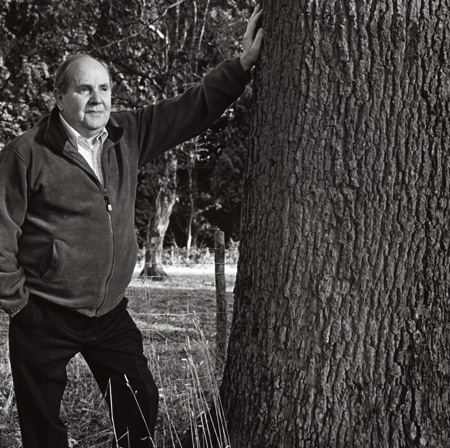|
Dad left school at 13 and
went straight to work in the Abdon quarries – this was in 1914.
They’d start work at daybreak, and from Abdon it was an hour’s
walk up the hill to the quarry before he’d even started to swing
a big hammer and a shovel. Dad was a ‘face-man’, breaking
the stone up with a 28lb hammer for eight hours a day. And they’d
be out in all weathers – it was one hell of a job.
Practically everybody who lived around here worked in the quarry. My
grandfather, my three uncles, they all worked there. A lot of them had
other jobs as well. If they were smallholders, they’d have to
deal with the stock before they went up, or work on the land after they’d
done a day’s graft on the hill. Dad had a big allotment and he’d
walk down the hill and do a couple of hours digging of an evening. They
were hard men.
People walked to the quarries from all over the area, from as far away
as Ludlow and Bridgnorth. Some of them lived rough, in old buildings
or anywhere, and used to go home weekends.
In the quarry they’d blast the rock first. They’d drill
holes into the face, tamp the black powder in, put the fuse in, seal
it with clay, light the fuse – and run like hell. Then it would
be broken up by hand into manageable pieces, so it could be lifted into
the rail trucks. Then it all went into the crusher.
Dhustone is very hard stone. The newer types working in the quarry would
just thrash at it with their hammers. But the old quarrymen would roll
a big stone over, and look at the grain; and perhaps with one or two
really good bumps on the top it would split open.
The quarrymen wore no protective clothing, nothing whatsoever. Not even
gloves. There’d be stone chips flying about, and they’d
always have nicks and cuts on their hands and arms. The chaps who were
sett-makers – chipping the stone into blocks for paving or building
– they used to have metal-mesh goggles; but I never saw anyone
else wearing them.
It was a hard life but I never knew the quarrymen to go on strike or
have any real problems with their employers. They were on good money.
When farm workers were getting 15–25 shillings a week (just under
or over £1), Dad was coming home with £5 or £6. They
were on piecework – they’d get so much for a truck of stone,
and so much for a truck of soil – so the more they did, they more
they earned. If they was on a good face that was all stone with very
little overburden, they were on a good thing.
The Abdon Clee quarries closed in 1936, when I was 11, but as a kid
I used to go up there and roam around, because everybody knew me, and
ride around on the ‘whizz-bangs’ – the little locomotives
moving the stone from the quarries to the crusher. They were ex-War
Department jobs, from the First World War. I knew the drivers and I
used to sit up on top of the engine cowling, with my legs dangling down
by the driver’s seat. It was great fun.
After the quarries closed, a lot of the quarrymen went to work at the
Cockshutford quarries on the other side of Brown Clee. But the dhustone
there wasn’t as good quality as over the Abdon side and that quarry
didn’t last long. So most of the men came back and worked at the
naval ammunition depot they’d set up at Ditton Priors at the start
of the war.
It’s very rural around Brown Clee now, but it was an industrial
place before the war, because there was the concrete plant and the tarmac
plant in Ditton Priors, plus the railway – and the quarries. If
the wind was coming down over the hill you could hear the crusher at
the top crunching away, even down in the village.
The quarries were all finished by the time I started work – so
I drove lorries and coaches most of my life. But I’m glad I never
had to work up there. I never fancied grafting like that.
Jim Parker, 14.10.1925 –
13.3.2004
|
